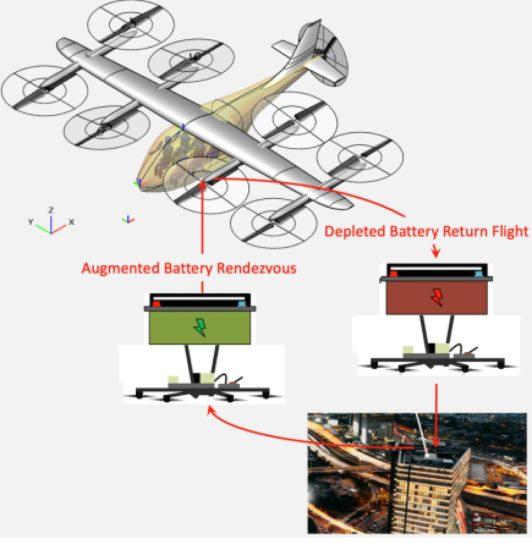Recharging Your eVTOLs – Midair
NASA Has Electrifying Plans for Your Advanced Air Mobility Vehicles

Swapping batteries midair, or more precisely, as NASA engineers describe their plan, “Energy Augmentation Concepts for Advanced Air Mobility Vehicles,” (EACAAMV) is a scheme devised by eight NASA scientists to recharge (if that’s the right word) eVTOLs in midair.
Kapil Sheth, Nhan Nguyen, Seth Schisler, Todd Stinchfield, Corey Ippolito (NASA Ames Research Center), David Pike and Thomas Lavelle (NASA Glenn Research Center), and Gary Qualls (NASA Langley Research Center) published their research in January 2023 on NASA’s Aviation Systems Division Website, although they don’t foresee their vision becoming reality until circa 2045.
Taking Charge – Indirectly
Effectively, it’s an autonomous rendezvous and docking concept, something akin to the methods currently used to refuel aircraft with liquid aviation fuel in flight, a process known aerial refueling [AKA air refueling, in-flight refueling (IFR), air-to-air refueling (AAR), or tanking]. The scientists considered two Indirect Charging and five Direct Charging concepts.
Beaming Voltage Instead of People
Whereas Star Trek afficionados will recall Captain Kirk’s legendary call to Scotty to reboard his spacecraft, “Beam me up, Scotty,” these NASA scientists propose beaming the voltage from the charging mechanism to the vehicle, a wireless, or indirect charging concept known as “power beaming.”
Three modalities could facilitate this radio frequency (RF) transfer: 1) Optical/Infrared, 2) Millimeter Wave, and 3) Microwave.
- Optical/Infrared charging would use a fiber-based laser input source which a modified photovoltaic (PV) cell mounted on the receiving vehicle would receive and then convert to an end power source.
- Alternatively, millimeter (mm) wave power beaming directly propagates millimeter waves for indirect charging. The mechanism’s relatively small footprint could be useful in short range charging.
- Remote charging uses a millimeter transmitter to wirelessly transfer energy to a phased array rectenna for RF-to-DC power conversion; this method, however would require an active heat exchanger be embedded on the AAM vehicle to dissipate excess heat.
Direct Connect
Direct charging methods being proposed yield five possible options: 1) Charging platforms, 2) Swappable Batteries, 3) Flying Batteries, 4) Cable Power, and 5) Hybrid.
- The charging platforms, elevated platforms disbursed throughout a city, would facilitate charging without having to land the AAM vehicle. Located strategically near vertiports, the platforms could be placed on rooftops or on existing skyrises, such as the Space Needle in Seattle, Washington.
- Another concept under consideration are swappable batteries. eVTOLs might carry spare batteries, a concept similar to ground vehicles that carry a spare two-gallon gas tank. Unlike a spare gas tank, however, spare batteries weigh the same whether charged or uncharged; weight remains an issue.
- Autonomous “flying batteries” could be positioned on blimps and guide themselves to the UAV where they dock, swap, and return the spent battery.
- Chargers outfitted with cables could connect to UAVs, but their usefulness could be hampered by the length of the cables and could be impacted by wind or other weather-related obstacles to charging.
- Also under consideration is a hybrid concept. This method combines charging platforms, swappable batteries, a flying battery, and cable power. This concept offers flexibility, but brings with it complexity.
In the end, advanced air mobility faces the same recharging challenge contemporary aviation faces: Time is money. The winning solution will be the one that keeps the UAVs in the air – earning money – the longest. The shortest turnaround time likely wins the recharging race.
Want to continue to stay up-to-date about the latest developments in the eVTOL industry? Subscribe to AeroCar Journal now. It’s FREE (for a limited time)! Join us on Twitter for the latest news, analysis, and insight about the eVTOL industry. AeroCarJ


